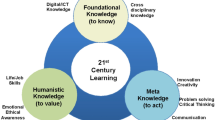Abstract
Innovation is globally an increasing necessity for Higher Education leadership. The paper makes a substantial distinction between innovation and effectiveness (or, ‘what works’ approach as per an evidence-based agenda). It considers main assumptions of dominant educational research on this matter and shows that they seek effectiveness (i.e. adaption to given contexts, procedures and aims) and conversely lack an adequate methodology to innovation. It suggests next that a more consistent and useful approach to innovation and leadership springs from the perspective of the Science of the Design along with Rationality of Action (SCD&RAC). Yet, there is a number of research lines containing the topic ‘design education’, the SCD&RAC framework is new and distinctive. Finally, the work draws implications for Higher Education and outlines some lines of research that emerge from this perspective.
Similar content being viewed by others
References
Argyris, C., & Schön, D. (1974). Theory in practice: Increasing professional effectiveness. San Francisco: Jossey-Bass.
Ayer, A. J. (Ed.). (1959). Logical positivism. New York: Free Press.
Barnett, R. (2018). The ecological university. London: Routledge.
Brown, S., & McIntyre, D. (1996). Making sense of teaching. Buckingham: OUP.
Clark, C.M., & Peterson, P.L. (1986). Teacher’s thought processes, in M.C. Wittock (ed), Handbook of Research on Teaching. New York: Macmillan.
Crosling, G., Nair, M., & Vaithilingam, S. (2015). A creative learning ecosystem, quality of education and innovative capacity. Studies in Higher Education. https://doi.org/10.1080/03075079.2014.881342.
Dressel, P. (2016). Policies and practices in higher education. The Journal of Higher Education. https://doi.org/10.1080/00221546.1961.11773392.
Dunne, J. (1993). Back to the Rough Ground: ‘Phronesis’ and ‘Techné’ in Modern Philosophy and in Aristotle. Notre Dame: UNDP.
Eckel, P., & Hartley, M. (2016). Develo** academic strategic alliances: Reconciling multiple institutional cultures, policies, and practices. The Journal of Higher Education. https://doi.org/10.1080/00221546.2008.11772121.
Elbaz, F. (1983). Teacher thinking: A study of practical knowledge. Londres: Croom Helm.
Eraut, M. (1995). Schön shock: A case for reframing reflection-in-action? Teachers and Teaching: theory and practice, 1, 9–22.
Hahn, N., Carnap, R., & Neurath, O. (1929). Wissenschaftleche Wltauffassung: Der Wiener Kreis. Viena: Wolff.
Hargreaves, D. (1996). Teaching as a research-based profession: Possibilities and prospects. Teacher Training Agency Annual Lecture. London: Teacher Training Agency.
Hempel, C. G., & Oppenheim, P. (1948). Studies in the logic of explanation. Philosophy of Science, 15, 135–175.
Hall, B., Jackson, E., Tandon, R., Fontan, JM., & Lall, N. (Eds.). (2013). Knowledge, democracy and action: Community-university research partherships in global perspectives. Manchester & NY: Manchester University Press.
Hora, M., & Smolarek, B. (2018). Examining faculty reflective practice: A call for critical awareness and institutional support. The Journal of Higher Education. https://doi.org/10.1080/00221546.2018.1437663.
Jones, S., & Harvey, M. (2017) Leading the academy: Building capacity through distributed leadership. Journal of Higher Education, Policy and Management. https://doi.org/10.1080/1360080X.2017.1276661
McIntyre, D. (2005). Bringing the gap between research and practice. Cambridge Journal of Education, 35(3), 357–382.
McKindsey&Company (2017) Technology, jobs, and the future of work. McKinsey Global Institute. Retrieved from: www.mckinsey.com/mgi
McKindsey&Company (2018) Superstars. The dynamics of firms, sectors and cities leading the global economy. McKinsey Global Institute. Retrieved from:www.mckinsey.com/mgi
McKindsey&Company (2019) Globalization in transition: the future of trade and value chanins. McKinsey Global Institute. Retrieved from: www.mckinsey.com/mgi
Pei-Ling, T. J., Choo, S. S., Kang, T., Gregory, A. D., & Liem, . (2017). Educating for twenty-first century competencies and future-ready learners: research perspectives from Singapore. Asia Pacific Journal of Education, 37(4), 425–436.
Penalva, J. (2011). The Role of Explanations and Prescriptions in the Science of the Design: the case of educational research. European Educational Research Journal. https://doi.org/10.2304/eerj.2011.10.2.272.
Penalva, J. (2014). The Non-theoretical View on Educational Theory: Scientific, Epistemological and Methodological Assumptions. Journal of Philosophyof Education. https://doi.org/10.1111/1467-9752.12087.
Penalva, J. (2019). Contemporary Methodological Perspectives in Educational Research on ‘Teachers’ practice’: Assumptions and Shortcomings for ‘Effective Practices.’ European Educational Research Journal. https://doi.org/10.1177/1474904119830902.
Penalva, J. (2020). Innovation, Personalized Education and Little Red Riding Hood. International Journal of Lifelong Education. https://doi.org/10.1080/02601370.2020.1786178.
Rescher, N. (1988). A philosophical inquiry into the nature and the rationale of reason. Oxford: Clarendon Press.
Rescher, N. (1999). Razón y valores en la Era científico-tecnológica. Barcelona: Paidós.
Salmon, W. C. (1990). Four decades of scientific explanations. Minneapolis: University of Minnesota Press.
Salmon, W. C. (1998). Causality and explanation. New York: Oxford University Press.
Schön, D. A. (1987). Educating the reflective practitioner. Toward a new design for teaching and learning in the professions. San Francisco: Joseey-Bass.
Schön, D. A. (1983). The reflective practitioner: How professionals think in action. New York: Basic Books.
Shanmugaratnam, Th. (2017a) Inclusive prosperity: Making it possible. LSE Event. https://www.youtube.com/watch?v=mQmpcuCP-hc
Shanmugaratnam, Th. (2017b) Inclusive Prosperity: making it possible. Deutsche Bundesbank. Frankfurt. https://www.youtube.com/watch?v=y_mYE_9jQok&t=236s
Shulman, L. (1987). Knowledge and teaching: Foundations of the new reform. Harvard Educational Review, 57, 1–22.
Simon, H. A. (1996). The Sciences of the Artificial (3a ed.). Cambridge, MA: The MIT Press.
Slavin, R. E. (2008). Perspectives on evidence-based research in education what works? Issues in synthesizing educational program evaluations. Educational Researcher, 37(1), 5–14.
Suppe, F. (1979) The Structure of Scientific Theories. Illinois: University of Illinois Press).
Weiss, C. (2016). Policy research in the context of diffuse decision making. The Journal of Higher Education. https://doi.org/10.1080/00221546.1982.11780501.
Wells, R., Kolek, E., et al. (2016). How we know what we know: A systematic comparison of research methods employed in Higher Education Journal. The Journal of Higher Education. https://doi.org/10.1080/00221546.2015.11777361.
Winch, P. (1958). The idea of social science and its relation to philosophy. USA: R&K.
Zubiri, X (1995) La estructura dinámica de la realidad. Madrid: Alianza, 2ª ed.
Author information
Authors and Affiliations
Corresponding author
Additional information
Publisher’s Note
Springer Nature remains neutral with regard to jurisdictional claims in published maps and institutional affiliations.
Rights and permissions
About this article
Cite this article
Penalva, J. Innovation and Leadership as Design: a Methodology to Lead and Exceed an Ecological Approach in Higher Education. J Knowl Econ 13, 430–446 (2022). https://doi.org/10.1007/s13132-021-00764-3
Received:
Accepted:
Published:
Issue Date:
DOI: https://doi.org/10.1007/s13132-021-00764-3




